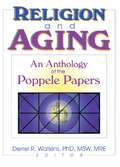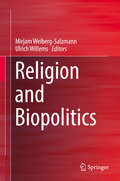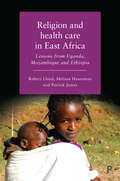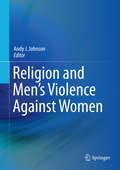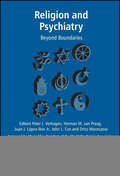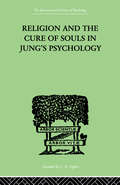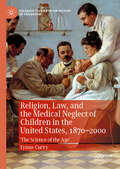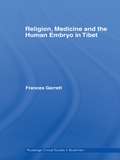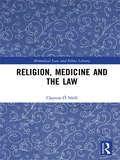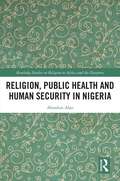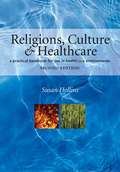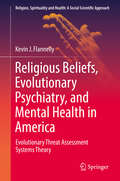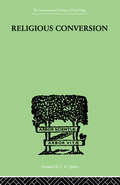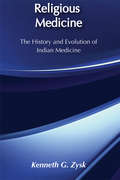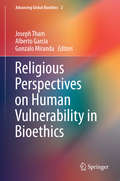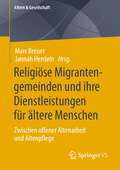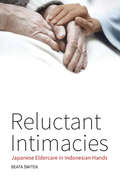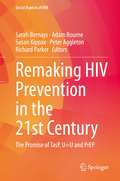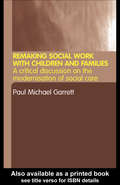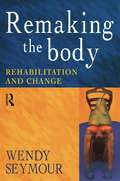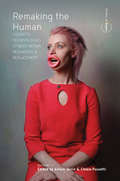- Table View
- List View
Religion and Aging: An Anthology of the Poppele Papers
by Derrell R. WatkinsFind solace and wise counsel in these classics of spiritual gerontology!In these days, when so many people live beyond the Biblical threescore and ten, the spiritual questing and questioning of the aged demands a meaningful response from clergy, family members, and nursing home staff. The essays and research studies reprinted in Religion and Aging: An Anthology of the Poppele Papers investigate the role of faith in older people's lives. Many of these classic studies have been updated with new information.These essays were originally published in the Quarterly Papers on Religion and Aging. This renowned journal was issued from 1984 to 1994 by the Poppele Center for Health and Welfare Studies at the Saint Paul School of Theology in Kansas City, Missouri. The issues of spiritual gerontology discussed in that journal are still powerfully relevant today. Because back issues of the journal are not widely available, the cream of its ten-year history is being reissued in permanent form.Religion and Aging offers unfailing wisdom and insight in a broad range of issues, including: training clergy to be more responsive to the needs of older people a historical perspective on the meaning of ”honoring thy father and mother” in first-century Judaism and Christianity the Psalms as a way to help nursing home residents deal with pain, loneliness, anger, and other difficult emotions original research into belief patterns of older Americans ways to give meaning to suffering suggested by the lives and works of Viktor Frankl, Martin Gray, and Rabbi Harold Kushner techniques of communicating with older people Religion and Aging is an invaluable resource to anyone who works with old people, whether in adult day-care programs, nursing homes, hospitals, or other senior citizens’groups. It will help chaplains, pastors, rabbis, and other clergy minister more effectively to the older members of their flock.
Religion and Biopolitics
by Ulrich Willems Mirjam Weiberg-SalzmannGiven the profound moral-ethical controversies regarding the use of new biotechnologies in medical research and treatment, such as embryonic research and cloning, this book sheds new light on the role of religious organizations and actors in influencing the bio-political debates and decision-making processes. Further, it analyzes the ways in which religious traditions and actors formulate their bio-ethical positions and which rationales they use to validate their positions. The book offers a range of case studies on fourteen Western democracies, highlighting the bio-ethical and political debates over human stem cell research, therapeutic and reproductive cloning, and pre-implantation genetic diagnosis. The contributing authors illustrate the ways in which national political landscapes and actors from diverse and often fragmented moral communities with widely varying moral stances, premises and commitments formulate their bio-ethical positions and seek to influence political decisions.
Religion and Health Care in East Africa: Lessons from Uganda, Mozambique and Ethiopia
by Robert Lloyd Melissa HaussmanWhat social factors contribute to the tragic state of health care in Africa? Focussing on East African societies, this book is the first to investigate what role religion plays in health care in African cultures. Taking in to account the geopolitical and economic environments of the region, the authors examine the roles played by individual and group beliefs, government policies, and pressure from the Millennium Development Goals in affecting health outcomes. Informed by existing related studies, and on-the-ground interviews with individuals and organisations in Uganda, Mozambique and Ethiopia this interdisciplinary book will form an invaluable resource for scholars seeking to better understand the links between society, multi-level state instruments, and health care in East Africa.
Religion and Men's Violence Against Women
by Andy J. JohnsonThis reference offers the nuanced understanding and practical guidance needed to address domestic violence, sexual assault, and human trafficking in diverse religious communities. Introductory chapters sort through the complexities, from abusers' distorting of sacred texts to justifying their actions to survivors' conflicting feelings toward their faith. The core of the book surveys findings on gender violence across Christian, Jewish, Islamic, Eastern, and Indigenous traditions--both attitudes that promote abuse and spiritual resources that can be used to promote healing. Best practices are included for appropriate treatment of survivors, their children, and abusers; and for partnering with communities and clergy toward stemming violence against women. Among the topics featured: Ecclesiastical policies vs. lived social relationships: gender parity, attitudes, and ethics. Women's spiritual struggles and resources to cope with intimate partner aggression. Christian stereotypes and violence against North America's native women. Addressing intimate partner violence in rural church communities. Collaboration between community service agencies and faith-based institutions. Providing hope in faith communities: creating a domestic violence policy for families. Religion and Men's Violence against Women will gain a wide audience among psychologists, social workers, marriage and family therapists, and other mental health professionals who treat religious clients or specialize in treating survivors and perpetrators of domestic and intimate partner violence, stalking, sexual assault, rape, or human trafficking.
Religion and Psychiatry
by Peter Verhagen Herman M. Van Praag John Cox Juan José López-Ibor Jr. Driss MoussaouiReligion (and spirituality) is very much alive and shapes the cultural values and aspirations of psychiatrist and patient alike, as does the choice of not identifying with a particular faith. Patients bring their beliefs and convictions into the doctor-patient relationship. The challenge for mental health professionals, whatever their own world view, is to develop and refine their vocabularies such that they truly understand what is communicated to them by their patients. Religion and Psychiatry provides psychiatrists with a framework for this understanding and highlights the importance of religion and spirituality in mental well-being. This book aims to inform and explain, as well as to be thought provoking and even controversial. Patiently and thoroughly, the authors consider why and how, when and where religion (and spirituality) are at stake in the life of psychiatric patients. The interface between psychiatry and religion is explored at different levels, varying from daily clinical practice to conceptual fieldwork. The book covers phenomenology, epidemiology, research data, explanatory models and theories. It also reviews the development of DSM V and its awareness of the importance of religion and spirituality in mental health.What can religious traditions learn from each other to assist the patient? Religion and Psychiatry discusses this, as well as the neurological basis of religious experiences. It describes training programmes that successfully incorporate aspects of religion and demonstrates how different religious and spiritual traditions can be brought together to improve psychiatric training and daily practice.Describes the relationship of the main world religions with psychiatryConsiders training, policy and service deliveryProvides powerful support for more effective partnerships between psychiatry and religion in day to day clinical careThis is the first time that so many psychiatrists, psychologists and theologians from all parts of the world and from so many different religious and spiritual backgrounds have worked together to produce a book like this one. In that sense, it truly is a World Psychiatric Association publication.Religion and Psychiatry is recommended reading for residents in psychiatry, postgraduates in theology, psychology and psychology of religion, researchers in psychiatric epidemiology and trans-cultural psychiatry, as well as professionals in theology, psychiatry and psychology of religion
Religion and the Cure of Souls In Jung's Psychology (International Library Of Psychology Ser.)
by Hans SchaerRoutledge is now re-issuing this prestigious series of 204 volumes originally published between 1910 and 1965. The titles include works by key figures such asC.G. Jung, Sigmund Freud, Jean Piaget, Otto Rank, James Hillman, Erich Fromm, Karen Horney and Susan Isaacs. Each volume is available on its own, as part of a themed mini-set, or as part of a specially-priced 204-volume set. A brochure listing each title in the "International Library of Psychology" series is available upon request.
Religion and the Health of the Public
by Gary R. Gunderson James R. CochraneThe book proposes a critical theory of the role and place of religion in public health and argues for a programmatic reorientation of these two fields of practice and inquiry to more effectively align religious health assets - widely present in many contexts - and public health services and facilities.
Religion in Global Health and Development: The Case of Twentieth-Century Ghana
by Benjamin Bronnert WalkerThe COVID-19 pandemic has made evident that the field of global health – its practices, norms, and failures – has the power to shape the lives of billions. Global health perspectives on the role of religion, however, are strikingly limited. Uncovering the points where religion and global health have connected across the twentieth century, focusing on Ghana, provides an opportunity to challenge narrow approaches.In Religion in Global Health and Development Benjamin Walker shows that the religious features of colonial state architecture were still operating by the turn of the twenty-first century. Walker surveys the establishment of colonial development projects in the twentieth century, with a focus on the period between 1940 and 1990. Crossing the colonial-postcolonial divide, analyzing local contexts in conjunction with the many layers of international organizations, and identifying surprisingly neglected streams of personnel and funding (particularly from Dutch and West German Catholics), this in-depth history offers new ways of conceptualizing global health.Patchworks of international humanitarian intervention, fragmented government services, local communities, and the actions of many foreign powers combined to create health services and the state in Ghana. Religion in Global Health and Development shows that religion and religious actors were critical to this process – socially, culturally, and politically.
Religion, Law, and the Medical Neglect of Children in the United States, 1870–2000: 'The Science of the Age' (Palgrave Studies in the History of Childhood)
by Lynne CurryDrawing upon a diverse range of archival evidence, medical treatises, religious texts, public discourses, and legal documents, this book examines the rich historical context in which controversies surrounding the medical neglect of children erupted onto the American scene. It argues that several nineteenth-century developments collided to produce the first criminal prosecutions of parents who rejected medical attendance as a tenet of their religious faith. A view of children as distinct biological beings with particularized needs for physical care had engendered both the new medical practice field of pediatrics and a vigorous child welfare movement that forced legislatures and courts to reconsider public and private responsibility for ensuring children’s physical well-being. At the same time, a number of healing religions had emerged to challenge the growing authority of medical doctors and the appropriate role of the state in the realm of child welfare. The rapid proliferation of the new healing churches, and the mixed outcomes of parents’ criminal trials, reflected ongoing uneasiness about the increasing presence of science in American life.
Religion, Medicine and the Human Embryo in Tibet (Routledge Critical Studies in Buddhism)
by Frances GarrettThis book explores the cultural history of embryology in Tibet, in culture, religion, art and literature, and what this reveals about its medicine and religion. Filling a significant gap in the literature this is the first in-depth exploration of Tibetan medical history in the English language. It reveals the prevalence of descriptions of the development of the human body – from conception to birth – found in all forms of Tibetan religious literature, as well as in medical texts and in art. By analysing stories of embryology, Frances Garrett explores questions of cultural transmission and adaptation: How did Tibetan writers adapt ideas inherited from India and China for their own purposes? What original views did they develop on the body, on gender, on creation, and on life itself? The transformations of embryological narratives over several centuries illuminate key turning points in Tibetan medical history, and its relationship with religious doctrine and practice. Embryology was a site for both religious and medical theorists to contemplate profound questions of being and becoming, where topics such as pharmacology and nosology were left to shape secular medicine. The author argues that, in terms of religion, stories of human development comment on embodiment, gender, socio-political hierarchy, religious ontology, and spiritual progress. Through the lens of embryology, this book examines how these concerns shift as Tibetan history moves through the formative 'renaissance' period of the twelfth through to the seventeenth centuries.
Religion, Medicine and the Law (Biomedical Law and Ethics Library)
by Clayton Ó NéillIs the legal protection that is given to the expression of Abrahamic religious belief adequate or appropriate in the context of English medical law? This is the central question that is explored in this book, which develops a framework to support judges in the resolution of contentious cases that involve dissension between religious belief and medical law, developed from Alan Gewirth’s Principle of Generic Consistency (PGC). <P><P>This framework is applied to a number of medical law case studies: the principle of double effect, ritual male circumcision, female genital mutilation, Jehovah’s Witnesses (adults and children) who refuse blood transfusions, and conscientious objection of healthcare professionals to abortion. <P><P>The book also examines the legal and religious contexts in which these contentious cases are arbitrated. It demonstrates how human rights law and the proposed framework can provide a gauge to measure competing rights and apply legitimate limits to the expression of religious belief, where appropriate. The book concludes with a stance of principled pragmatism, which finds that some aspects of current legal protections in English medical law require amendment.
Religion, Public Health and Human Security in Nigeria (Routledge Studies on Remote Places and Remoteness)
by Abiodun AlaoThis book critically examines the intersection of religion, public health and human security in Nigeria. Focusing on Christianity, Islam, traditional religions and "intra-religious" doctrinal divergencies, the book explores the impact faith has on health-related decisions and how this affects security in Nigeria. The book assesses the connection between religion and five contemporary major health and medical issues in the country. This includes the issue of epidemics and pandemics such as the Covid-19 pandemic, vaccines, contraception, blood transfusion and the controversies associated with "miracle healing". In particular, the book explores situations where individuals have the power of choice but instead, embraces faith and religious positions that contradict science in the management of their health and, in the process, expose themselves and others to personal health insecurity. It investigates aspects of human security including the wider international ramifications of health issues, approaches to cures and the interpretation of causes of diseases, as well as the ethno-religious connotations of such interpretations. Exploring key issues that have brought religion into the politics of health and human security in Nigeria, this book will be of interest to students and scholars in the field of African Religion, African Politics, African Studies, public health, security, and Sociology.
Religions, Culture and Healthcare: A Practical Handbook for Use in Healthcare Environments, Second Edition
by Susan HollinsHealth professionals provide care to patients of differing religions and cultures, and knowledge of their cultural and religious background, way of life and beliefs and practices is vital to delivering sensitive and responsive care. This revised and updated guide provides practical and comprehensive information on each of the major faiths, providing an accessible reference for appropriate day to day care of patients in multicultural societies. Healthcare professionals, including doctors, nurses, midwives, healthcare assistants, physiotherapists, psychologists, hospital chaplains and administrative staff will find it an indispensable ready reference.
Religious Beliefs, Evolutionary Psychiatry, and Mental Health in America
by Kevin J. FlannellyThis book provides a new perspective on the association between religious beliefs and mental health. The book is divided into five parts, the first of which traces the development of theories of organic evolution in the cultural and religious context before Charles Darwin. Part II describes the major evolutionary theories that Darwin proposed in his three books on evolution, and the religious, sociological, and scientific reactions to his theories. Part III introduces the reader to the concept of evolutionary psychiatry. It discusses how different regions of the brain evolved over time, and explains that certain brain regions evolved to protect us from danger by assessing threats of harm in the environment, including other humans. Specifically, this part describes: how psychiatric symptoms that are commonly experienced by normal individuals during their everyday lives are the product of brain mechanisms that evolved to protect us from harm; the prevalence rate of psychiatric symptoms in the U. S. general population; how religious and other beliefs influence the brain mechanisms that underlie psychiatric symptoms; and the brain regions that are involved in different psychiatric disorders. Part IV presents the findings of U. S. studies demonstrating that positive beliefs about God and life-after-death, and belief in meaning-in-life and divine forgiveness have salutary associations with mental health, whereas negative beliefs about God and life-after-death, belief in the Devil and human evil, and doubts about one's religious beliefs have pernicious associations with mental health. The last part of the book summarizes each section and recommends research on the brain mechanism underlying psychiatric symptoms, and the relationships among these brain mechanisms, religious beliefs, and mental health in the context of ETAS Theory.
Religious Conversion: a Bio-Psychological Study
by Sante de SanctisThis is Volume II of six in a collection on Psychology and Religion. Originally published in 1927, this is a Bio-Psychological study with a special aim (the reconstruction of the empirical Ego), and its own method (introspection).
Religious Medicine: History and Evolution of Indian Medicine
by Kenneth G. ZyskThis book outlines the history and development of the Indian healing arts from Vedic medicine to classical ayurveda. It elucidates a healing tradition based on magico-religious beliefs and practices.
Religious Perspectives on Human Vulnerability in Bioethics
by Joseph Tham Gonzalo Miranda Alberto GarciaWith the advance of biomedicine, certain individuals and groups are vulnerable because of their incapacities to defend themselves. The International Bioethics Committee as a UNESCO working group has for the last several years dedicated to deepen this principle of human vulnerability and personal integrity. This book serves to supplement this effort with a religious perspective given a great number of the world's population is affiliated with some religious traditions. While there is diversity within each of these traditions, all of them carry in them the mission to protect the weak, the underprivileged, and the poor. Thus, here presented is a collection of papers written by bioethics experts from six major world religions--Buddhism, Christianity, Confucianism, Hinduism, Islam and Judaism--who were gathered to discuss the meaning and implications of the principle of vulnerability in their respective traditions.
Religiöse Migrantengemeinden und ihre Dienstleistungen für ältere Menschen: Zwischen offener Altenarbeit und Altenpflege (Altern & Gesellschaft)
by Marc Breuer Jannah HerrleinWelche Relevanz haben religiöse Migrantengemeinden für die alltägliche Unterstützung und Pflege von älteren Menschen mit Migrationserfahrung? Professionelle Dienstleistungen der Altenhilfe werden in der genannten Bevölkerungsgruppe bislang nur unterdurchschnittlich genutzt. Gleichzeitig ist bekannt, dass migrantische Religionsgemeinschaften vielfältige soziale Dienstleistungen erbringen. Das Buch verbindet Erkenntnisse und Perspektiven aus Gerontologie, Migrations- und Religionssoziologie, Soziologie des Alter(n)s, Sozialer Arbeit und Sozialpolitikforschung sowie aus den theologischen Wissenschaften verschiedener Religionsgemeinschaften. Zahlreiche Gemeinden positionieren sich als Akteure einer offenen Altenarbeit oder stellen Anschlüsse zur professionellen Altenpflege her.
Relocation Issues in Child Custody Cases
by Philip M. Stahl Leslie M. DrozdFind out how evaluators, mediators, and judges deal with the issues of relocation in divorced familiesIn the past, the relocation of a parent or child in custody cases was rarely a problem for divorced families-there was little conflict and little need for court intervention. But with the growth of shared custody, more fathers involved in parenting after divorce, and an increase in litigation between conflicted parents, relocation has become a complex issue that&’s difficult for evaluators, judges, and public policymakers to resolve. Relocation Issues in Child Custody Cases offers a firsthand look at how evaluators investigate, predict, and make recommendations; how judges reach decisions based on those recommendations; and how individual states deal with relocation cases. Relocation Issues in Child Custody Cases examines how evaluators, mediators, and judges can best facilitate an environment where a child has an ongoing relationship with two parents, regardless of where each parent lives. This unique book looks at how the landscape in relocation cases has changed since the California Supreme Court&’s landmark 2004 ruling in the LaMusga move-away case, examining relevant topics, including individual state statutes on relocation; a survey of courts in the United States; the functions of an evaluator; how a judge analyzes data before reaching a decision; parental conflict; domestic violence; change of circumstances; primary residence; and the process of developing parenting plans. Relocation Issues in Child Custody Cases examines: whether negative outcomes of parental relocation after divorce were a result of pre-existing conflict and domestic violence whether the "best interests of the child" is an acceptable standard in relocation cases investigative models for evaluators "for the move" and "against the move" biases-and how to reduce them a format for analyzing evidence in relocation cases the risks and benefits of presumptions in family law matters and much moreRelocation Issues in Child Custody Cases is an essential resource for evaluators, mediators, judges, caseworkers, child psychologists, family therapists, and child advocates.
Reluctant Intimacies: Japanese Eldercare in Indonesian Hands
by Beata ŚwitekBased on seventeen months of ethnographic research among Indonesian eldercare workers in Japan and Indonesia, this book is the first ethnography to research Indonesian care workers’ relationships with the cared-for elderly, their Japanese colleagues, and their employers. Through the notion of intimacy, the book brings together sociological and anthropological scholarship on the body, migration, demographic change, and eldercare in a vivid account of societal transformation. Placed against the background of mass media representations, the Indonesian workers’ experiences serve as a basis for discussion of the role of bodily experience in shaping the image of a national “other” in Japan.
Remaking HIV Prevention in the 21st Century: The Promise of TasP, U=U and PrEP (Social Aspects of HIV #5)
by Richard Parker Peter Aggleton Susan Kippax Sarah Bernays Adam BourneThis edited collection brings together the social dimensions of three key aspects of recent biomedical advance in HIV research: Treatment as Prevention (TasP), new technologies such as Pre-Exposure Prophylaxis (PrEP), and the Undetectable equals Untransmittable (U=U) movement. The growth of new forms of biomedical HIV prevention has created hope for the future, signalling the possibility of a world without AIDS. In this context, the volume discusses the profound social, political and ethical dilemmas raised by such advances, which are to do with readiness, access, equity and availability. It examines how HIV prevention has been, and is, re-framed in policy, practice and research, and asks: How best can new biomedical technologies be made available in a profoundly unequal world? What new understandings of responsibility and risk will emerge as HIV becomes a more manageable condition? What new forms of blame will emerge in a context where the technologies to prevent HIV exist, but are not always used? How best can we balance public health’s concern for adherence and compliance with the rights of individuals to decide on what is best for themselves and others? Few of these questions have thus far received serious consideration in the academic literature.The editors, all leaders in the social aspects of HIV, have brought together an innovative and international collection of essays by top thinkers and practitioners in the field of HIV. This book is an important resource for academics and professionals interested in HIV research.Chapters "Anticipating Policy, Orienting Services, Celebrating Provision: Reflecting on Scotland’s PrEP Journey", "How the science of HIV treatment-as-prevention restructured PEPFAR’s strategy: The case for scaling up ART in ‘epidemic control’ countries", "Stigma and confidentiality indiscretions: Intersecting obstacles to the delivery of Pre-Exposure Prophylaxis to adolescent girls and young women in east Zimbabwe" and "The drive to take an HIV test in rural Uganda: a risk to prevention for young people?" are available open access under a Creative Commons Attribution 4.0 International License via link.springer.com.
Remaking Social Work with Children and Families: A Critical Discussion On The Modernisation Of Social Care
by Paul Michael GarrettRemaking Social Work with Children and Families provides a sustained examination of the 'modernisation' of this area of social care. It analyses some of the key themes introduced by the administrations of John Major and Tony Blair and provides a critical exploration of contemporary policy initiatives and issues. These include:· the Looking After Children (LAC) materials· The Framework for the Assessment of Children in Need and Their Families· 'working together' to protect children· the mainstream approach to 'race' and ethnicity in social work· the implications for social work of the emergence of 'personal advisers', mentors and related professionals.The author argues that political and ideological factors need to be taken into account in order to understand the dominant discourses and evolving practices of social work with children. Potential fixation with ensuring that young people are able to 'fit' into their allotted roles in a market economy and an overarching concern about children and criminality have been crucial in this respect. He concludes that while social workers and educators should be prepared to embrace change, they need to be critical agents in the process of change, recognising the ever present need to promote and foster democracy within the sphere of social welfare.This timely book will be helpful to all students, educators and social care professionals who are seeking to develop their theoretical and practical understanding of a changing profession.
Remaking the Body: Rehabilitation and Change
by Wendy SeymourIn Remaking the Body, Wendy Seymour interviews men and women who have suffered profound bodily paralysis, and explores how they deal with their appearance, relationships, sexuality, incontinence and sport. She finds that even major impairment hasn't annihilated these people's experience of an embodied self. She shows that the process of self-reconstruction is interwoven with social expectations and argues that the experience of disability highlights the continuous work involved in embodiment for everyone. Remaking the Body is a major contribution to the field of the sociology of the body and essential reading for rehabilitation professionals and students.
Remaking the Human: Cosmetic Technologies of Body Repair, Reshaping, and Replacement (Politics of Repair #2)
by Alvaro Jarrín Chiara PussettiThe technological capacity to transform biology - repairing, reshaping and replacing body parts, chemicals and functions – is now part of our lives. Humanity is confronted with a variety of affordable and non-invasive 'enhancement technologies': anti-ageing medicine, aesthetic surgery, cognitive and sexual enhancers, lifestyle drugs, prosthetics and hormone supplements. This collection focuses on why people find these practices so seductive and provides ethnographic insights into people’s motives and aspirations as they embrace or reject enhancement technologies, which are closely entangled with negotiations over gender, class, age, nationality and ethnicity.
Remaking the Human: Cosmetic Technologies of Body Repair, Reshaping, and Replacement (Politics of Repair #2)
by Alvaro Jarrín Chiara PussettiThe technological capacity to transform biology - repairing, reshaping and replacing body parts, chemicals and functions – is now part of our lives. Humanity is confronted with a variety of affordable and non-invasive 'enhancement technologies': anti-ageing medicine, aesthetic surgery, cognitive and sexual enhancers, lifestyle drugs, prosthetics and hormone supplements. This collection focuses on why people find these practices so seductive and provides ethnographic insights into people’s motives and aspirations as they embrace or reject enhancement technologies, which are closely entangled with negotiations over gender, class, age, nationality and ethnicity.
